Lipscomb University
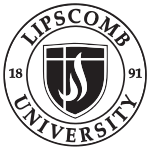 | |
| Motto | "The Truth Shall Make You Free" – John 8:32 |
|---|---|
| Type | Private liberal arts college |
| Established | 1891 |
Religious affiliation | Churches of Christ |
| Endowment | US$ 70.4 million[1] |
| Chairman | David Scobey[2] |
| President | L. Randolph Lowry III |
| Provost | W. Craig Bledsoe |
Academic staff | 343[3] |
| Students | 4,632[3] |
| Undergraduates | 2,986 |
| Postgraduates | 1,646 |
| Location | Nashville, Tennessee, U.S. |
| Campus | Urban, 83 acres (34 ha) |
| Colors |
Purple and Gold[4] |
| Athletics | NCAA Division I – ASC |
| Nickname | Bisons |
| Mascot | LU the Bison |
| Affiliations |
CCCU[5] NAICU[6] TICUA[7] |
| Website |
www |
 | |
Lipscomb University is a private, coeducational, liberal arts university in Nashville, Tennessee, United States. It is affiliated with the Churches of Christ. The campus is located in the Green Hills neighborhood of Nashville between Belmont Boulevard to the west and Granny White Pike on the east. Student enrollment for the fall 2016 semester is 4,632 which includes 2,986 undergraduate students and 1,646 graduate students. It also maintains a location called "Spark" in the Cool Springs area of Williamson County.[8]
History
Lipscomb University was founded in 1891 by David Lipscomb and James A. Harding. The campus grounds consist predominantly of the former estate of David Lipscomb, who donated it to the school. The school was never intended to function as a seminary, although a seminary is a part of the university, but rather as a Christian liberal arts institution. In fact, in an early catalog, the founders expressed their views about providing a liberal education with spiritual exploration.
We purpose to present in the way of a liberal education as extensive a curriculum as can be found in any school, college, or university in the land, and at the same time to thoroughly drill its students in the Bible, the divine source of wisdom and goodness. It was not our design to make professional preachers, but to train males and females, young and old, all who might become members of the school, for the greatest usefulness in life. Each student is left to choose his own calling.— James A. Harding, Course Catalog, 1896-97
Several prominent Church of Christ religious ministers received at least a portion of their higher education there (see "Notable alumni" below), and the institution remains thoroughly affiliated in the Churches of Christ: Potential full-time, undergraduate faculty must prove their membership in a Church of Christ before being hired.[9]
Its original name was the Nashville Bible School, which was changed to David Lipscomb College, then to David Lipscomb University. Lipscomb graduated its first senior class in 1948, leaving behind the name of "junior college" forever. In 1954, the Southern Association of Colleges and Schools granted Lipscomb its first accreditation.[10] In 1988, Lipscomb attained Level III (master's degree-granting) status and became known as David Lipscomb University. In 2005, the "David" was legally dropped, and the institution was renamed simply Lipscomb University.
All full-time, undergraduate students are required to take Bible classes and attend chapel twice a week. (Half of these chapels are now held in the sports facility Allen Arena, and half are "break-out" sessions that are held in multiple places at once.)[11]
In addition to the university campus, there is also an on-campus high school and middle school; the associated elementary school moved to a renovated former public school a few blocks away in 1986. All three comprise Lipscomb Academy, offering Pre-kindergarten through high school education.
Presidents
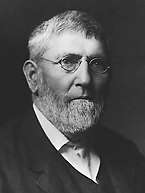
There have been 13 superintendents or presidents of Lipscomb over 17 administrations.
- James A. Harding (1891-1901)
- William Anderson (1901-1905)
- J. S. Ward (1905-1906)
- E. A. Elam (1906-1913)
- J. S. Ward (1913)
- H. Leo Boles (1913-1920)
- A. B. Lipscomb (1920-1921)
- H. S. Lipscomb (1921-1923)
- H. Leo Boles (1923-1932)
- Batsell Baxter (1932-1934)
- E. H. Ijams (1934-1943)
- Batsell Baxter (1943-1946)
- Athens Clay Pullias (1946-1977)
- G. Willard Collins (1977-1986)
- Harold Hazelip (1987-1997)
- Steve Flatt (1997-2005)
- L. Randolph Lowry III (2005–present)
The Nashville Bible School was co-founded by David Lipscomb and James A. Harding in 1891. David Lipscomb never served as president, but as chairman of the board of trustees. James A. Harding served as the school's first superintendent.
Academics
U.S. News & World Report ranks Lipscomb University 18th among Regional Universities (South)[12] according to the U.S. News & World Report's "2015 America's Best Colleges" guidebook. Lipscomb's liberal arts curriculum includes a wide range of academic programs in the arts and sciences. The curriculum continues to evolve, notably with the addition of civil and environmental engineering in the Raymond B. Jones College of Engineering and the doctorate in pharmacy in the College of Pharmacy and Health Sciences.
Under the administration of President Lowry, Lipscomb increased the number of its graduate programs from 8 in 2005 to 44 in 2015.
Colleges and institutes
Lipscomb University comprises the following colleges, schools and institutes:
Colleges:
|
Schools:
Institutes:
|
Campus information
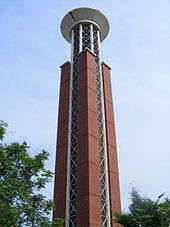
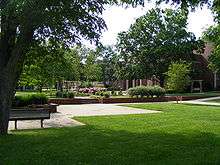
The center of the university, known as Bison Square, is located between the Bennett Campus Center and the Willard Collins Alumni Auditorium. The south side of the Bennett Campus Center was converted from a single upstairs and downstairs entry into an amphitheater-style seating area and entryway, as well as having an entirely renovated interior with redesigned seating and lighting that create a more welcoming atmosphere. A full-service Starbucks store has also opened inside the campus center, complete with its own separate entry on both the interior and exterior of the building. The bricked square is traditionally used during warm weather as the location for devotionals, concerts, and other campus activities.
Willard Collins Alumni Auditorium has been completely renovated with new seating, flooring, and audio/video equipment, updating its look from the original design. Attached to Alumni Auditorium is the A. M. Burton Health Sciences Center. The Burton building was heavily renovated to house the College of Pharmacy. The entire renovation of the building received LEED Gold certification. On the southeast corner of Burton, is the music wing, the McMeen Music Center, with a large rehearsal room for music ensembles on the main level, with music offices and practice rooms on the lower level.
To the south side of Burton is the Swang Business Center where business and Computing classes are held.
The university's newest academic buildings—the Pharmacy Research Center, the James D. Hughes Center for both engineering and visual arts, and the Nursing and Health Sciences Center—have opened as the university expands past its traditional northern boundary. The Ezell Center comprises the religious, education, mass communication, social work, history, political science, philosophy, and professional studies departments. Other academic buildings include the McFarland Hall of Sciences where the science and math classes are held, and Ward Hall with renovations similar to those in Alumni Auditorium.
Beaman Library was constructed in time for the university's centennial in 1991. The university's old library, the Crisman building, now serves as the university's administrative building.
Allen Arena, a 5,028-seat multipurpose facility, opened in October 2001 on the site of the old McQuiddy Gymnasium. Part of the McQuiddy Gymnasium still remains between Allen Arena and the Student Activities Center (the SAC), a multipurpose student activity space with workout facilities, basketball courts and an indoor track. The SAC offers a variety of workout classes to students, including spin classes on exercise bikes. Yearwood Hall, a women's dormitory, was torn down for construction of Allen Arena and its accompanying parking garage.
The university has six residence halls. Women's residences include Elam Hall, Fanning Hall, and Johnson Hall, all of which have a large enclosed courtyard. Men's residences include Sewell Hall, which was renovated in the late 1990s, and the eight-story High Rise, the university's tallest structure. The final residence on campus is The Village, a co-ed, apartment style housing for upperclassmen. Men and women are not allowed in dorms belonging to the opposite sex, with a few exceptions: 1) members of both sexes can enter the lobby during certain hours, 2) during moving days, and 3) on "open dorm" occasions; 4) and men are also allowed into the central courtyard of the women's dormitories only when cookouts or other such mixers are being held.
Tax exempt bonds
Some academic buildings were built with tax-exempt municipal bonds, and, because Lipscomb is a Christian school, this led to an extended lawsuit on the basis of whether or not a private religious institution is allowed to use public bonds. This case was debated for many years and ultimately made it to the Supreme Court.[13]
The court upheld the decision of the lower court, that, plainly stated, the government could not withhold public bonds based on Lipscomb's religious affiliation. However, one of the stipulations for receiving public funding was that these buildings cannot have religious classes taught in them. For example, no Bible classes are taught in the McFarland Hall of Sciences; however, the rule about excluding Bible classes does not apply to Ward Hall, even though it is attached to McFarland Hall. Construction of Ward was funded through private donations. This decision has allowed other private, religious universities to pursue public funding for capital projects.
Campus life
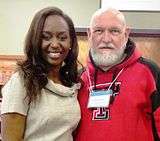
Lipscomb does not have fraternities and sororities. Rather, it has social clubs, which are local and unique to Lipscomb University and are not part of any national Greek system. The women's social clubs include Alpha Zeta, Delta Sigma, Delta Omega, Kappa Chi, Phi Nu, Phi Sigma, Gamma Lambda, and Pi Delta. The men's social clubs are Delta Nu, Sigma Omega Sigma, Sigma Iota Delta, Theta Psi, and Tau Phi.
Students participate in Singarama (an annual spring musical variety show), as well as other entertainment, social, and service activities throughout the year. The university also offers membership in other academic, professional, and service clubs including Alpha Kappa Psi International Business Fraternity (Delta Kappa chapter), Sigma Alpha Iota women's music fraternity, Alpha Phi Chi men's service club, Pi Kappa Sigma women's service club, Sigma Pi Beta co-ed service club, Alpha Chi National Honors Society, Sigma Tau Delta National English honor society, Circle K International, College Republicans, and College Democrats.
The Babbler is the defunct student newspaper and was published weekly during the spring and fall semesters. The title of the publication comes from Acts 17:18 which in part says "What does this babbler have to say?"[14] The Backlog is the school's yearbook and is published annually. The Lumination Network, the school's converged student media outlet, replaces the weekly Babbler and is tied heavily with the academic program of the Department of Communication and Journalism.[15]
Global learning
Lipscomb offers a handful of study abroad programs, which the university terms global learning. In the mid-1990s a semester-long, study abroad program in Vienna, Austria, was first offered, and is the flagship trip for the university. Additional study abroad trips include Santiago, Chile; Florence, Italy; and London, England. Several academic departments take short trips to various sites around the world. These trips are usually for fewer than 10 hours credit and a shorter time abroad. The university also partners with the Council for Christian Colleges and Universities to offer other trips ranging from 10 days to year-round, thanks to the newly developed programs of 2013. The current head of the global learning department is Michael Winegeart.
Athletics
Sports teams are nicknamed "The Bisons," and there is a large statue of the namesake animal centrally located on the campus. At one time the school was a small-college sports powerhouse, notably in baseball and basketball in the NAIA; now it is a member of NCAA Division I and competes in the Atlantic Sun Conference.
The university has an ongoing sports rivalry with Belmont University, just 3 miles (4.8 km) down the road from Lipscomb. Traditionally basketball games between the two schools are called the "Battle of the Boulevard". Overall the Bisons have the series advantage 73-63.
In 2006, the rivalry reached a new level when Belmont and Lipscomb advanced to the finals of the Atlantic Sun tournament at the Memorial Center in Johnson City, Tennessee, with the winner earning its first-ever bid to the NCAA tournament. Belmont won 74–69 in overtime. Lipscomb was invited to the National Invitation Tournament as the regular-season conference champion, losing in its first game.
The Lipscomb Bisons traditionally include the "s", though the plural of "bison" is usually not "bisons." However, some dictionaries list this as a rare usage (and the Oxford English Dictionary points out that in Latin the plural is "bisontes").
The Bison serves as the official mascot of Lipscomb University. LU The Bison, a costumed Mascot, can be seen at basketball, baseball, soccer, and volleyball games as well as other non-athletic events on and around the Lipscomb campus.
On November 13, 2007, the Lipscomb women's basketball team defeated Fisk University 123-22 in one of the most lopsided games in NCAA history.[16]
Notable alumni
- Michael F. Adams (1970), retired president of the University of Georgia, chancellor of Pepperdine University.
- Kelsea Ballerini, American country music singer and songwriter
- LaMar Baker (1938), politician
- Richard A. Batey (H.S. 1951, David Lipscomb College 1955), New Testament scholar
- Robert Henry Boll, German-born American preacher in the Churches of Christ
- Casey Bond (2009), American actor, former professional baseball player
- Pat Boone (H.S. 1952), singer
- Charles R. Brewer (1918), professor, preacher, poet, and leader
- G. C. Brewer (1911), author, preacher, and teacher
- Rex Brothers (2011), professional baseball player for the Colorado Rockies
- Savannah Chrisley, reality television personality and pageant queen
- Douglas A. Foster (1974), author and scholar known for his work on the history of Stone-Campbell Restoration Movement
- B.C. Goodpasture (1918), preacher and writer
- Judy G. Hample (1969), former Chancellor of the Pennsylvania State System of Higher Education (PASSHE)
- David Edwin Harrell (1954), historian at Auburn University
- Beth Halteman Harwell (1978), State Representative (Tennessee) Speaker of the House in the Tennessee House of Representatives. First female speaker.
- Jim Jinkins (1975), creator of the animated Doug series
- Caleb Joseph (2010), professional baseball player for the Baltimore Orioles
- W. Mark Lanier (1981), founder of The Lanier Law Firm
- Dustin Lynch (2007), American country music singer and songwriter
- Kayla Montgomery, award-winning long distance runner.
- Michael Shane Neal (1991), portrait artist
- Ira L. North (1941), preacher and author
- Monty Powell, Award winning country music singer, songwriter and producer
- Thomas Rhett (2011), American country music singer and songwriter
- Kerry Roberts (1983), state senator (Tennessee)
- Marty Roe (1984), lead singer of the country music band Diamond Rio
- David Sampson (1978), former United States Deputy Secretary of Commerce
- William R. Snodgrass (1942), Tennessee Comptroller of the Treasury
- Barry Stowe (1979), CEO, Jackson National Life[17]
- J. Ridley Stroop (1921), psychology and biblical professor, known for his interference research in experimental psychology known as the Stroop Effect.
- Edwin Trevathan (1977), former physician and public health leader, national center director at the U.S. Centers for Disease Control and Prevention (CDC), provost at Baylor University.
- Ray Walker (1956), bass singer for The Jordanaires quartet
References
- ↑ "U.S. and Canadian Institutions Listed by Fiscal Year 2015 Market Value of Endowment Assets and Change in Endowment Market Value from FY2014 to FY2015" (PDF). NACUBO.org. National Association of College and University Business Officers. 2015. Retrieved October 25, 2016.
- ↑ "David Scobey". Lipscomb University. Retrieved March 28, 2015.
- 1 2 "Fast Facts". Lipscomb University. Retrieved November 9, 2016.
- ↑ Lipscomb University Brand Identity Guide and Stylebook (PDF). 2016-01-01. Retrieved 2016-04-10.
- ↑ Council for Christian Colleges & Universities - Members & Affiliates
- ↑ NAICU – Member Directory
- ↑ TICUA Member Institutions
- ↑ "Lipscomb Goes Extra Mile with Opening of 'Spark'". 2013-02-02. Retrieved 2014-03-14.
- ↑ "What it means to work at Lipscomb - Human Resources | Lipscomb University". Lipscomb University. Retrieved 10 December 2015.
- ↑ "Institution Details". Southern Association of Colleges and Schools Commission on Colleges. Retrieved 26 February 2014.
- ↑ "Chapel - Student Life | Lipscomb University". Lipscomb University. Retrieved 10 December 2015.
- ↑ "Lipscomb University | Best College | US News". 2014. Retrieved 2013-09-10.
- ↑ Industrial Development Board of Metropolitan Government of Nashville and Davidson County v. Harry E. Steele, et al., 537 U.S. 1188 (2003).
- ↑ "About The Babbler". Lipscomb.edu. Retrieved March 17, 2010.
- ↑ "Lumination". Retrieved August 27, 2010.
- ↑ "Lipscomb decimates Fisk with 101-point margin". USA Today. 2007-11-14. Retrieved 2007-11-14.
- ↑ "Jackson National Life CEO returns to Nashville roots". tennessean. July 7, 2015. Retrieved 14 October 2015.
External links
Coordinates: 36°06′21″N 86°47′51″W / 36.1058°N 86.7976°W